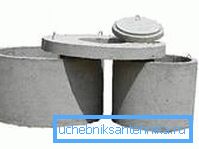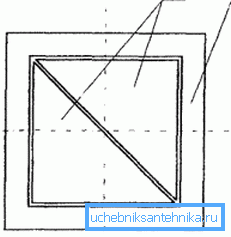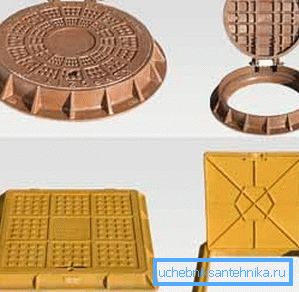Hatches for wells - we are defined with a task and we act
When we talk about manholes for wells, then these terribly heavy “washers” with a diameter of 70-80 cm immediately appear in our minds, with which every single more or less significant settlement is stuck together — without canalization, what can you do. But on the other hand, when we speak about wells, we do not mean the urban underground networks - we mean water wells outside the city. Therefore, to begin with, it is necessary to decide - what kind of hatches are we talking about, and what should they nevertheless close, for what purpose.

Prose of life for summer residents

Therefore, we proceed, setting out the main provisions of the topic:
- we are certainly talking about hatches for your water well in the country;
- but the fact is that the production technology of the hatches has such a long history, it has acquired such standards that you probably should not reinvent the wheel and even at the dacha to close your well, you should install a standard "city" hatch, by the way, and it will be discussed;
- such an approach does not limit the initiative of everyone, and you will be free to close your well from above in any way, but there are already mysterious ways;
Helpful advice! Even in this situation, most likely, you will be offered large cast-iron lids, but we advise you to pay attention to the thick foam plates. They perfectly protect against ingestion of an outsider, and, in addition, provide good thermal insulation. Foam plates are also easily cut, so you can create a lid of the desired shape with your own hands.

- along the way, another question arises - why are you going to close the well from above; there may be several answers to this:
- you use the well in the traditional way, by drawing water from above, the lid is for you, therefore, you do not need it all the time, but you are going to leave the cottage for a while and want to protect the well;
- you have included the well in the general water supply system of the house, water comes from the well through pipes, so there is no need to collect it with a bucket, which means it is desirable that there is a reliable sunroof protecting from above.
Helpful advice! Even if the well is included in the water supply system, we advise you not to burn the bridges behind you and leave the opportunity to draw water from above yourself. The ways are inscrutable, sooner or later, with force majeure, it may be necessary. In the end - the electricity was gone and the water supply pump is not working, and in the tank, unfortunately, it is empty - I don’t drag such a rare situation.
So hatches
It is quite possible that there are rectangular hatches and oval, but the shape of the overwhelming majority of them is determined by the structures from which the well is created, and they have only two forms according to the photo "A":
- A is round and
- B is square.
Thus, we can mostly talk about the dimensions of the hatches and how to fix them during installation. But here standards come into play.
All about manufacturing requirements
The main regulations that define the parameters of the hatches are the following:
- GOST 3634-99 - defines all the characteristics of both hatches and storm water inlets of storm sewage system wells;
- EN 124-1994 - the standard in Europe - is also given, labeling, and signs of quality control.
Options
Thus, if you are going to get yourself a cast-iron hatch, the following will be at your disposal (Russian / European labeling):
- LM / A15 - for installation in green areas and in pedestrian areas:
- load (kN) - 15;
- diameter (mm) - 450;
- installation depth (mm) - 20;
- weight (kg) - 45;
- C / B125 - for sidewalks and the carriageway with parameters, respectively: 125/550/25/95;
- T / S250 - for strong loads: 250/550/35/120;
- ST / E600 - for airfields and docks (this is already, well, very far from the cottages, but still): 600/550/60/155.
Here are three types of most common hatches:
- A - the most common type of hatch, used everywhere, with a cover (1), a body (2) and its supporting surface (3);

- B - the hatch with the locking lock: 1 - a cover; 2 - housing; 3 - locking mechanism.

- C - this configuration has a recess for filling with concrete; there is also a cover (1), a concrete base (2) and a cover body (3).
Standards define two types of fixing hatches:
- and - with the special fixing anchor bolts;
- b - with fixation due to the design of the installation groove through special tides.

Acceptance control
This thing is too important - a well hatch, so be sure to check their quality for the following characteristics:
- on the surface of the pothole no more than 10 mm in length and 3 mm in depth, and the total area of the potholes should be no more than 5% of the total area of the hatch;
- The presence of cracks on the surface is unacceptable, this indicates violations of the casting technology, which is not permissible in principle;
- if there are remains of slag inside, this is permissible, but slag is not allowed more than 10% of the area of the hatch;
- on the surface of the hatch should be applied relief with a height of 2 to 8 mm, depending on the destination;
- if the relief of the hatch is convex, its area is necessarily in the range from 10 to 70% of the area of the hatch;
- the hatch must have a slot for opening it;
- when installing the hatch, the gap to the well cannot be more than 3 mm;
- Installation should be made on an elastic gasket with a hardness of more than 40 units. (on the scale of Shor).
- the installation grooves must be evenly distributed around the perimeter of the hatch;
- Each hatch must be labeled.
Polymers
The ubiquitous plastic has penetrated into such a sphere as hatches for closing wells, because this material:
- durable - it is very resistant to constant exposure to water, chemicals, mechanical effects in a variety of types;
- is easy - therefore, its installation is performed without the use of large physical force or auxiliary lifting equipment;
- easy to use - most likely, the polymer hatch for the well, you will not need to mechanically straighten somehow, but if it is required, it will not cause major problems - you can trim it a little or drill it with any suitable tool;

- reliable in their designs - connections that have passed the test of time - "tongue and groove" will never fail, even under the most severe operating conditions;
- presented in a wide variety of colors - what else do you need to pay attention to a dangerous place or add a color nuance to the surrounding design, even the garden.
The polymer manhole for concrete wells is usually supplied in the following modifications (the price is given for orientation according to the Moscow region, the dimensions of the hatches for the wells are in mm):
- dimensions - 780 x 780 x 90; weight - 12.83 kg; price - 2300 rubles - green;
- dimensions - 780 x 780 x 90; weight - 12.83 kg; price - 1950 rubles - black;
- dimensions - 800 x 800 x 70; weight - 11 kg; price - 3500 rubles - black.

findings
Will the standard cover with a manhole for the well serve as a protection from above or you create something of your own, it is up to you and your masters to decide. But it is logical that if you use standard rings to form a well and do not intend to draw water yourself, use a standard hatch as protection from above (learn here how to decorate a well).
You just have to choose the material, shape, color. The instruction and video in this article which contains all necessary recommendations will help to establish.